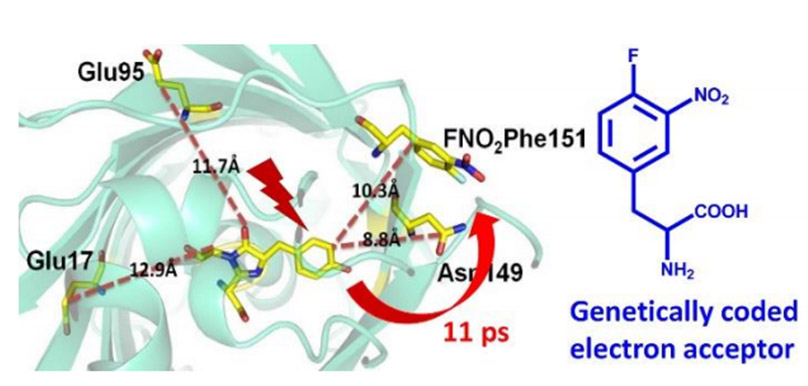A Genetically Encoded Electron Acceptor Enables Photoinduced Electron Transfer in Green Fluorescent Protein
Electron transfer (ET) is widely used for driving the processes that underlie the chemistry of life. Photoinduced electron transfer (PET) during photosynthesis initiates the process to harvest light energy in plants and cyanobacteria. Imitation of PET in a small model protein not only would facilitate our understanding of biological electron transfer, but also would provide a useful tool for rational design of reductases. Our abilities to probe electron transfer mechanisms in proteins and design redox enzymes are limited, due to the lack of methods to site-specifically insert electron acceptors into proteins in vivo.
Jiangyun Wang group from Institute of Biophysics, Chinese Academy of Sciences , in collaboration with Dr. Andong Xia from Institute of Chemistry, realized PET in a small model protein, green fluorescent protein (GFP) with the help of an unnatural amino acid. They developed a system to incorporate 4-fluoro-3-nitrophenylalanine (FNO2Phe) into protein through genetic codon expansion. The unnatural amino acid has similar reduction potentials to NAD(P)H and ferredoxin, the most important biological reductants. By measuring femtosecond transient absorption spectra of GFP variants containing FNO2Phe, they showed that PET from the GFP chromophore to FNO2Phe occurs very fast (within 11 picoseconds), comparable to that of the first electron transfer step in photosystem I, from P700* to A0. This genetically encoded, low-reduction potential unnatural amino acid (UAA) can significantly improve our ability to investigate electron transfer mechanisms in complex reductases, and facilitate the design of miniature proteins which mimic their functions.
This work entitled “Ultrafast Photo-induced Electron Transfer in Green Fluorescent Protein Bearing a Genetically Encoded Electron Acceptor” was published online in Journal of the American Chemical Society on May 29, 2015.
This work was supported by grants from the Major State Basic Research Program of China, the National Natural Science Foundation of China and the Chinese Academy of Sciences.

Fig. Genetically encoded electron acceptor(image by Jiangyun Wang group)

